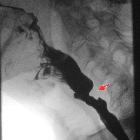Globus pharyngeus

Globus pharyngeus is the subjective feeling of a lump in the throat which can have a variety of causes, it is not a diagnosis in its own right. In modern practice globus is often evaluated by flexible nasoendoscopy in the first instance since many patients present to otorhinolaryngology services. If no cause is identified or if nasoendoscopy cannot be tolerated patients are frequently referred for fluoroscopic swallowing studies.
Terminology
Often referred to as simply globus, it is sometimes misleadingly - and anachronistically - dubbed globus hystericus, which historically refers to a subjective sensation of a lump in the throat that has been ascribed to anxiety. This relates to the outdated notion that cases of globus with no identifiable cause were due to "hysteria". This term should not now be used .
Current approaches focus on treating underlying causes where possible and developing strategies to manage the condition.
Epidemiology
It is difficult to ascertain the prevalence of this symptom, but in one study up to 45% of people reported a sensation of globus at least once. It is thought to constitute up to 4% of otolaryngology clinic visits . It has an equal prevalence among men and women.
Pathology
The pathogenesis of globus is not understood. Authors have suggested visceral hypersensitivity, enlarged tonsils, gastro-esophageal reflux, laryngopharyngeal reflux and mental health conditions as being implicated. While isolated cases of malignancy have been reported in associated with globus there is no consensus established in the literature to suggest globus is sensitive or specific for an underlying malignancy. There is evidence to suggest that when there is an associated malignancy there are often accompanying red flag signs of neoplastic disease .
Radiographic features
Fluoroscopy forms the mainstay for imaging patients with dysphagia. This is usually in the form of barium swallow, which can be extended to include assessment of the stomach and duodenum. A water soluble contrast agent can be used in the place of barium if there is a risk of or suspected aspiration.
Fluoroscopy
- filling defect or mucosal irregularity may be seen in the pharynx or upper esophagus if there is a neoplasm, though this is very rare
- evidence of gastro-esophageal reflux may be noted
- pharyngeal pouch may be demonstrated
History and etymology
The Latin word 'globus' means a sphere, from which comes the feeling of having a ball or lump in the throat .
Siehe auch:

 Assoziationen und Differentialdiagnosen zu Globusgefühl:
Assoziationen und Differentialdiagnosen zu Globusgefühl:

